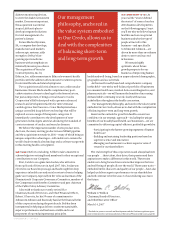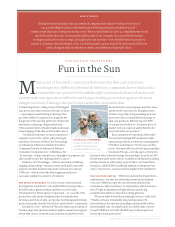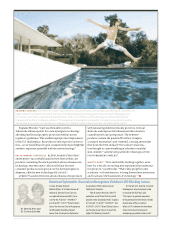Johnson and Johnson 2006 Annual Report Download - page 19
Download and view the complete annual report
Please find page 19 of the 2006 Johnson and Johnson annual report below. You can navigate through the pages in the report by either clicking on the pages listed below, or by using the keyword search tool below to find specific information within the annual report.
of experienced adult patients, such as those who have failed or
are resistant to more than one protease inhibitor. It may allow
patients who have lived with a low level of virus for years to
attain an undetectable viral load, a goal that is consistent with
current treatment guidelines,” says Roger Pomerantz, M.D.,
FACP, President, Tibotec Research and Development.
“In this respect, the development of PREZISTA™ has taught
us a great deal about how to treat global infectious disease in
general,” continues Pomerantz. “It showed us that long-term
suppression of viruses and microbes requires the development
of compounds that ‘fit’ a virus very neatly—and likewise fit
patients’ needs.” Additional studies are ongoing to evaluate
long-term outcomes of PREZISTA™ therapy.
SCIENCE AS HERO The 15-year-long behind-the-scenes
story of how Tibotec created PREZISTA™ illustrates how nimble,
creative science was able to find a way to increase the
genetic barrier to resistance for an insidious “smart” virus
that has proved itself a master of disguise, mutation and
opportunistic survival.
Stoffels recalls: “By the late 1990s, the so-called ‘cocktail’ of
drug therapies seemed to have turned AIDS into a manageable
chronic disease, much like diabetes. But the hidden reality was
that the virus was continuing to build up resistance, threatening
to destroy the hopes of people who were working so hard to
live full and productive lives. As a patient, hearing that your
HIV infection has become drug-resistant—and that your viral
load is increasing, not decreasing—is the second-worst day of
your life, exceeded only by the day your physician gave you
the original diagnosis.
“We felt we had to go the extra mile for that patient,
no matter how long or arduous the task ahead—so we put
our heads, hearts and hands to work. Through an exceptional
commitment of the entire organization at Tibotec and Virco,
within record time we were able to discover and develop a novel
drug while we were building a new organization. Our people are
the core of our success. The entire team is committed to making
the difference for patients living with HIV/AIDS globally.”
Tibotec-Virco Vice President of Scientific Operations
Kurt Hertogs, who has been at Stoffels’ side from the beginning,
W H E R E I T A L L B E G A N Paul Stoffels, M.D. (right), Company Group Chairman, Research and Development,
is reunited in Mechelen, Belgium, with three founding members of his AIDS-fighting research team
(clockwise from bottom): Hilde Azijn, Senior Scientist, Tibotec Clinical Virology; Kurt Hertogs, Vice President,
Tibotec-Virco Scientific Operations; and Marie-Pierre de Bethune, Vice President, Tibotec Clinical Virology.
H U M A N S V S . M I C R O B E S 17
























